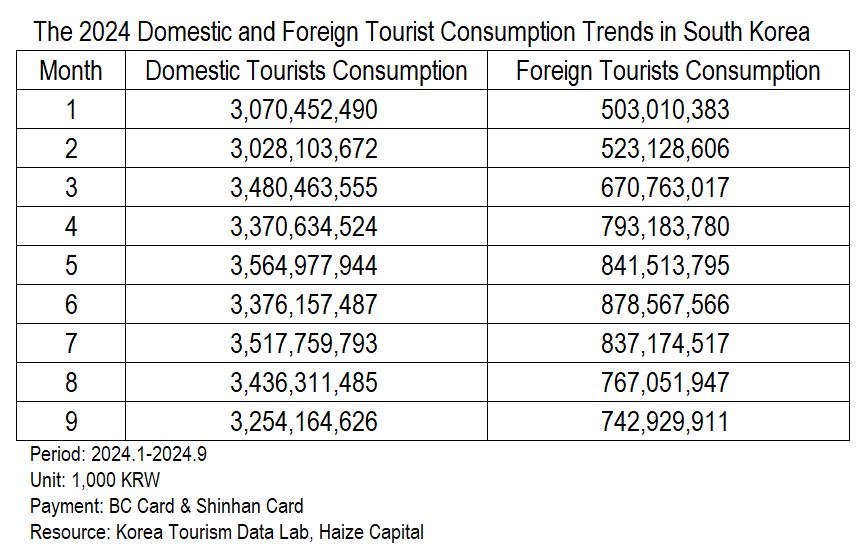

登錄


登錄
海擇短評 Haize Comment:
2024韓國國民旅遊趨勢走向短途旅行
2024年棋至終盤,各國旅遊相關數據的趨勢也逐步明確。從這個角度看韓國的國民旅遊,其中之一的趨勢,相信會是短途旅行的風行與連帶影響。
按照韓國旅遊數據實驗室(한국관광데이터랩에)所調取的行動通訊數據,今(2024)年1月至9月,韓國人的國內旅行(判定方式為手機離開日常生活區並在特定基地台覆蓋區停留30分鐘以上)次數為21.9億人次,較去年同期微增1.8%;而最大的特點是,相較去年,這些旅遊人群從國內長途旅行迅速轉變為到周邊進行短途旅行。該推論由以下數據支持或相關:
1. 與2023年同期相比,出行的總人次相仿;但從各城市旅遊相關行業的國內旅客消費金額來看,除了景區門票業增長59%外,其餘交通運輸業、住宿業、休閒服務業、購物業與餐飲業都出現降幅,分別達14.7%、9.0%、7.2%、6.0%、6.0%。特別通過交通與住宿費用降低,推斷原因與國內旅客偏好短途一日遊相關。
2. 區域旅遊現況的分析數據也佐證了這一點。南韓的地方自治區主要分為"廣域市"和"道"兩種主要類別,總共包含17個自治區;而韓國旅遊數據實驗室的數據顯示,1月至8月,全國17個自治區的國內旅客停留時間均有所下降,與去年同期相比平均下降8%。下降幅度最大的前三大地區分別為濟州島、江原道與蔚山,降幅分別為18.6%、16.8與11.1%。
3. 若從地方自治區的過夜遊客率來看,除了四個廣域特別市(首爾特別市、釜山廣域市、大邱廣域市、仁川廣域市)略有增長,其餘全數下降。
4. 比較特別的是,周邊短途旅遊的消費金額,也與城市的大小有關。韓國國內旅客在仁川的旅遊消費額約為1.5兆韓元,比去年同期成長了0.7%;但以江原道為例,國內旅客總支出為9,500億韓元,與去年同期相比減少了6.6%,降幅頗大。
海擇資本認為,雖然韓國旅遊數據實驗室的消費數據僅代表BC卡(類似台灣的聯合信用卡)與新韓卡(新韓金融集團旗下的信用卡)兩種信用卡消費,但已具有足夠覆蓋廣度,且跨年度的比較標準一致,仍具有參考價值。雖然還不能貿然認定韓國的國民旅遊人群,從國內長途旅行轉變為到周邊進行短途旅行是否基於經濟緊縮而撙節支出,但可以推定,過往韓國當地玩樂產業的深度與產品數都遠不如日本豐富,若相關趨勢延續,隨著短途旅行的風行,有可能帶動韓國當地玩樂產業供應鏈的起飛。
----
Haize Capital Insights of the Day
2024 Korean Domestic Travel Trends Shift Toward Short Trips
As we near the end of 2024, trends in travel-related data across various countries are becoming increasingly clear. One of the emerging trends in Korean domestic tourism is the rise of short trips and its related impact.
According to mobile data sourced from the Korea Tourism Data Lab (한국관광데이터랩에), from January to September of this year (2024), the number of domestic trips taken by Koreans (determined by mobile phones leaving daily living zones and staying within the coverage of a specific cell tower for more than 30 minutes) reached 2.19 billion, a slight increase of 1.8% compared to the same period last year. However, the most notable feature is the shift from long-distance domestic travel to shorter, nearby trips. This conclusion is supported by the following data:
1. Compared to 2023, the total number of trips is similar. However, based on the domestic tourist spending in travel-related industries across various cities, there has been a decrease in transportation, accommodation, leisure services, shopping, and dining, with drops of 14.7%, 9.0%, 7.2%, 6.0%, and 6.0%, respectively, while spending on scenic spot tickets increased by 59%. The reduction in transportation and accommodation spending particularly suggests a preference for shorter one-day trips among domestic travelers.
2. Data analyzing the current state of regional tourism also supports this trend. South Korea’s 17 local autonomous regions, which are divided into "metropolitan cities" and "provinces," saw an overall decrease in the average length of stay by domestic travelers from January to August, with an average decline of 8% compared to the same period last year. The three regions with the largest drops were Jeju Island, Gangwon Province, and Ulsan, with declines of 18.6%, 16.8%, and 11.1%, respectively.
3. In terms of the overnight stay rate by region, the four major metropolitan cities (Seoul Special City, Busan Metropolitan City, Daegu Metropolitan City, and Incheon Metropolitan City) saw slight growth, while all other regions experienced a decline.
4. Interestingly, spending on nearby short trips also appears to correlate with the size of the city. For instance, domestic tourists' spending in Incheon reached 1.5 trillion KRW, a 0.7% increase compared to the same period last year. In contrast, Gangwon Province saw a significant decrease, with total domestic tourist spending dropping by 6.6% to 950 billion KRW.
Haize Capital believes that although the consumption data from the Korea Tourism Data Lab only reflects transactions made using BC Card (similar to Taiwan's joint credit card) and Shinhan Card (a credit card issued by the Shinhan Financial Group), the coverage is broad enough and the year-over-year comparison standard is consistent, providing valuable insights. While it is premature to conclude that the shift from long-distance domestic travel to nearby short trips is directly due to economic tightening, it is reasonable to assume that Korea's local leisure industry has historically lacked the depth and variety of Japan’s. If this trend continues, the rise of short trips may drive the growth of the domestic leisure industry’s supply chain in Korea.

標籤 Label: SouthKorea DataLab BCCard ShinhanCard ShortTrips ThingsToDo DomesticTravel